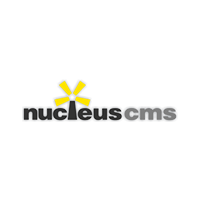Nucleus CMS


Please feel free to contact us
Go
An AWS product NucleusCMS Pure Publishing Blog Management powered by Miri Infotech. NucleusCMS is an open-source blog management software package written in PHP, with a MySQL backend. It is used to manage frequently-updated Web content. With a little tweaking (mainly to skins), it might be considered a lightweight content management system. It can resides on your webserver. It Includes multiple weblog capabilities, and RSS syndication.
We are launching a product which will configure and publish NucleusCMS, an open source CMS software solution which is embedded pre-configured tool with LAMP and ready-to-launch AMI on Amazon EC2 that contains NucleusCMS, Apache, MySQL, Linux, PHP (LAMP).
NucleusCMS has a range of features which can be extended further by plugins some of which are shipped as standard. Some new skin vars are recently added:
User interaction features include:
You can subscribe to WordPress, an AWS Marketplace product and launch an instance from the product’s AMI using the Amazon EC2 launch wizard.
Open the URL:http://<instance ip address>
Step1: Select Language.
System Configuration
Step2: Database Information
Host Name : localhost
Database Name : mirinucleusdb
Username : mirinucleuscms
Password : <InstanceID>
Step3: Admin User Information
Fill Password<InstanceID> , Display Name
Step4: Delete your install files or rename you install folder.
For Delete install files you need to with putty.
Step5: Now your site url is http://<instanceID>
Step6: Admin url is http://<instanceID>/nucleus
SSH using root user is disabled. ec2-user is the sudo user with root privileges with access using the key pair created during launching the instance.
MYSQL can be accessed only with SSH
MYSQL User : root
Password :<InstanceID>
Note : You are not supposed to change it.
All your queries are important to us. Please feel free to connect.
24X7 support provided for all the customers.
We are happy to help you.
Submit your Query: https://miritech.com/contact-us/
Contact Numbers:
Contact E-mail:
You may connect your VPC to:
Traditional hosting services generally provide a pre-configured resource for a fixed amount of time and at a predetermined cost. Amazon EC2 differs fundamentally in the flexibility, control and significant cost savings it offers developers, allowing them to treat Amazon EC2 as their own personal data center with the benefit of Amazon.com’s robust infrastructure.
When computing requirements unexpectedly change (up or down), Amazon EC2 can instantly respond, meaning that developers have the ability to control how many resources are in use at any given point in time. In contrast, traditional hosting services generally provide a fixed number of resources for a fixed amount of time, meaning that users have a limited ability to easily respond when their usage is rapidly changing, unpredictable, or is known to experience large peaks at various intervals.
Secondly, many hosting services don’t provide full control over the compute resources being provided. Using Amazon EC2, developers can choose not only to initiate or shut down instances at any time, they can completely customize the configuration of their instances to suit their needs – and change it at any time. Most hosting services cater more towards groups of users with similar system requirements, and so offer limited ability to change these.
Finally, with Amazon EC2 developers enjoy the benefit of paying only for their actual resource consumption – and at very low rates. Most hosting services require users to pay a fixed, up-front fee irrespective of their actual computing power used, and so users risk overbuying resources to compensate for the inability to quickly scale up resources within a short time frame.
No. You do not need an Elastic IP address for all your instances. By default, every instance comes with a private IP address and an internet routable public IP address. The private address is associated exclusively with the instance and is only returned to Amazon EC2 when the instance is stopped or terminated. The public address is associated exclusively with the instance until it is stopped, terminated or replaced with an Elastic IP address. These IP addresses should be adequate for many applications where you do not need a long lived internet routable end point. Compute clusters, web crawling, and backend services are all examples of applications that typically do not require Elastic IP addresses.
There are two types of VPN connections that you can create: statically-routed VPN connections and dynamically-routed VPN connections. Customer gateway devices supporting statically-routed VPN connections must be able to:
In addition to the above capabilities, devices supporting dynamically-routed VPN connections must be able to:
Amazon RDS manages the work involved in setting up a relational database: from provisioning the infrastructure capacity you request to installing the database software. Once your database is up and running, Amazon RDS automates common administrative tasks such as performing backups and patching the software that powers your database. With optional Multi-AZ deployments, Amazon RDS also manages synchronous data replication across Availability Zones with automatic failover.
Since Amazon RDS provides native database access, you interact with the relational database software as you normally would. This means you’re still responsible for managing the database settings that are specific to your application. You’ll need to build the relational schema that best fits your use case and are responsible for any performance tuning to optimize your database for your application’s workflow.
When a minor version of a database engine is deprecated in Amazon RDS, we will provide a three (3) month period after the announcement before beginning automatic upgrades. At the end of the this period, all instances still running the deprecated minor version will be scheduled for automatic upgrade to the latest supported minor version during their scheduled maintenance windows.
When a major version of database engine is deprecated in Amazon RDS, we will provide a minimum six (6) month period after the announcement of a deprecation for you to initiate an upgrade to a supported major version. At the end of this period, an automatic upgrade to the next major version will be applied to any instances still running the deprecated version during their scheduled maintenance windows.
Once a major or minor database engine version is no longer supported in Amazon RDS, any DB instance restored from a DB snapshot created with the unsupported version will automatically and immediately be upgraded to a currently supported version.
Taking control of your site with a content management system also has great advantages as far as your search engine rankings are concerned. All search engines like to see that websites are updated regularly and favor sites that alter their content on a regular basis. Our CMS platform provides search engine friendly web pages and also allows you to create your own page titles and meta tags used by the Search Engines for page rankings.
The CMS is browser-based and will work on both PC and Mac platforms using either Internet Explorer and Firefox. Keyboard shortcuts may vary between the two systems.
When in doubt, avoid using non-numerical or -alphabetical characters.
Requirements gathering is crucial, to make sure you buy on what you need, not on the shiny features that look good in the demonstration.
Another important factor is how easy the system is to use – most likely, the people you’d like to update the site won’t be that technically comfortable, so the best solution is one that has solid usability.
no. That is the biggest myth of CMSs. Most of the time, the real issues in content creation are around people and processes, not the technology. You need to manage your content creation like any other project – with a clear workflow and timetable, and enough people—with the right skills—to handle what you need to create. The CMS will help you get the content on to the site, but the much more difficult challenge is creating it. And computers don’t write very well.
The Web CMS does not require any special software or any technical knowledge to use. It is a web-based platform and can be accessed wherever you have an Internet connection and a web browser. The interface is very similar to Microsoft Word and does all of the HTML coding for you. You can concentrate on the content and not worry about how it will affect the page layout. It also automatically optimizes your site’s content for search, so that when someone searches for information on your site it is more likely to be found.
It provides Maintenance for one or more weblogs/news-sites, Authors, Categories, Built-in commenting system, FancyURLs
Runs on your own server, Drafts and Future Posts, Fully Tweakable, Plugins etc.
It provides Bookmarklet and right-click blogging, Archives and Search, RSS and Atom Syndication, File/Image Upload, IP-banlist, Backup/Restore
 NucleusCMS
NucleusCMS  php
php  apache
apache  mysql
mysql  linux
linux